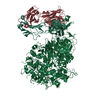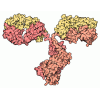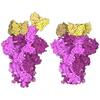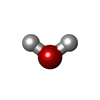[English] 日本語
 Yorodumi
Yorodumi- PDB-8ror: Single-particle cryo-EM of Mycoplasma pneumoniae adhesin P1 compl... -
+ Open data
Open data
- Basic information
Basic information
| Entry | Database: PDB / ID: 8ror | |||||||||||||||||||||
|---|---|---|---|---|---|---|---|---|---|---|---|---|---|---|---|---|---|---|---|---|---|---|
| Title | Single-particle cryo-EM of Mycoplasma pneumoniae adhesin P1 complexed with the anti-adhesive Fab fragment. | |||||||||||||||||||||
 Components Components |
| |||||||||||||||||||||
 Keywords Keywords | CELL ADHESION / Adhesin / Mycoplasma pneumoniae / Sialic acid / Adhesion | |||||||||||||||||||||
| Function / homology |  Function and homology information Function and homology informationattachment organelle / adhesion of symbiont to microvasculature / cell projection / cell surface / membrane / plasma membrane Similarity search - Function | |||||||||||||||||||||
| Biological species |  Mycoplasmoides pneumoniae M129 (bacteria) Mycoplasmoides pneumoniae M129 (bacteria) | |||||||||||||||||||||
| Method | ELECTRON MICROSCOPY / single particle reconstruction / cryo EM / Resolution: 2.39 Å | |||||||||||||||||||||
 Authors Authors | Vizarraga, D. / Kawamoto, A. / Marcos-Silva, M. / Fita, I. / Miyata, M. / Pinyol, J. / Namba, K. / Kenri, T. | |||||||||||||||||||||
| Funding support |  Spain, Spain,  Japan, 2items Japan, 2items
| |||||||||||||||||||||
 Citation Citation |  Journal: PLoS Pathog / Year: 2025 Journal: PLoS Pathog / Year: 2025Title: Dynamics of the adhesion complex of the human pathogens Mycoplasma pneumoniae and Mycoplasma genitalium. Authors: David Vizarraga / Akihiro Kawamoto / Marina Marcos-Silva / Jesús Martín / Fumiaki Makino / Tomoko Miyata / Jorge Roel-Touris / Enrique Marcos / Oscar Q Pich / David Aparicio / Ignacio Fita ...Authors: David Vizarraga / Akihiro Kawamoto / Marina Marcos-Silva / Jesús Martín / Fumiaki Makino / Tomoko Miyata / Jorge Roel-Touris / Enrique Marcos / Oscar Q Pich / David Aparicio / Ignacio Fita / Makoto Miyata / Jaume Piñol / Keiichi Namba / Tsuyoshi Kenri /   Abstract: Mycoplasma pneumoniae and Mycoplasma genitalium are bacterial wall-less human pathogens and the causative agents of respiratory and reproductive tract infections. Infectivity, gliding motility and ...Mycoplasma pneumoniae and Mycoplasma genitalium are bacterial wall-less human pathogens and the causative agents of respiratory and reproductive tract infections. Infectivity, gliding motility and adhesion of these mycoplasmas to host cells are mediated by orthologous adhesin proteins forming a transmembrane adhesion complex that binds to sialylated oligosaccharides human cell ligands. Here we report the cryo-EM structure of M. pneumoniae P1 adhesin bound to the Fab fragment of monoclonal antibody P1/MCA4, which stops gliding and induces detachment of motile cells. The epitope of P1/MCA4 involves residues only from the small C-domain of P1. This epitope is accessible to antibodies only in the "closed conformation" of the adhesion complex and is not accessible in the "open" conformation, when the adhesion complex is ready for attachment to sialylated oligosaccharides. Polyclonal antibodies generated against the large N-domain of P1 or against the whole ectodomain of P40/P90 have little or no effects on adhesion or motility. Moreover, mutations in the highly conserved Engelman motifs found in the transmembrane helix of M. genitalium P110 adhesin also alter adhesion and motility. These results show that antibodies directed to the C-domain of P1 hinder the large conformational rearrangements in this domain required to alternate between the "open" and "closed" conformations of the adhesion complex. Since transition between both conformations is essential to complete the attachment/detachment cycle of the adhesion complex, interfering with the gliding of mycoplasma cells and providing a new potential target to confront M. pneumoniae and M. genitalium infections. | |||||||||||||||||||||
| History |
|
- Structure visualization
Structure visualization
| Structure viewer | Molecule:  Molmil Molmil Jmol/JSmol Jmol/JSmol |
|---|
- Downloads & links
Downloads & links
- Download
Download
| PDBx/mmCIF format |  8ror.cif.gz 8ror.cif.gz | 371.4 KB | Display |  PDBx/mmCIF format PDBx/mmCIF format |
|---|---|---|---|---|
| PDB format |  pdb8ror.ent.gz pdb8ror.ent.gz | 287.7 KB | Display |  PDB format PDB format |
| PDBx/mmJSON format |  8ror.json.gz 8ror.json.gz | Tree view |  PDBx/mmJSON format PDBx/mmJSON format | |
| Others |  Other downloads Other downloads |
-Validation report
| Summary document |  8ror_validation.pdf.gz 8ror_validation.pdf.gz | 1.2 MB | Display |  wwPDB validaton report wwPDB validaton report |
|---|---|---|---|---|
| Full document |  8ror_full_validation.pdf.gz 8ror_full_validation.pdf.gz | 1.2 MB | Display | |
| Data in XML |  8ror_validation.xml.gz 8ror_validation.xml.gz | 67.3 KB | Display | |
| Data in CIF |  8ror_validation.cif.gz 8ror_validation.cif.gz | 100.2 KB | Display | |
| Arichive directory |  https://data.pdbj.org/pub/pdb/validation_reports/ro/8ror https://data.pdbj.org/pub/pdb/validation_reports/ro/8ror ftp://data.pdbj.org/pub/pdb/validation_reports/ro/8ror ftp://data.pdbj.org/pub/pdb/validation_reports/ro/8ror | HTTPS FTP |
-Related structure data
| Related structure data |  19402MC M: map data used to model this data C: citing same article ( |
|---|---|
| Similar structure data | Similarity search - Function & homology  F&H Search F&H Search |
- Links
Links
- Assembly
Assembly
| Deposited unit | 
|
|---|---|
| 1 |
|
- Components
Components
| #1: Protein | Mass: 158195.531 Da / Num. of mol.: 1 Source method: isolated from a genetically manipulated source Source: (gene. exp.)  Mycoplasmoides pneumoniae M129 (bacteria) Mycoplasmoides pneumoniae M129 (bacteria)Gene: mgpA, MPN_141, MP013 / Production host:  |
|---|---|
| #2: Antibody | Mass: 24149.861 Da / Num. of mol.: 1 Source method: isolated from a genetically manipulated source Source: (gene. exp.)   |
| #3: Antibody | Mass: 23883.730 Da / Num. of mol.: 1 Source method: isolated from a genetically manipulated source Source: (gene. exp.)   |
| #4: Water | ChemComp-HOH / |
| Has protein modification | Y |
-Experimental details
-Experiment
| Experiment | Method: ELECTRON MICROSCOPY |
|---|---|
| EM experiment | Aggregation state: PARTICLE / 3D reconstruction method: single particle reconstruction |
- Sample preparation
Sample preparation
| Component |
| ||||||||||||||||||||||||||||
|---|---|---|---|---|---|---|---|---|---|---|---|---|---|---|---|---|---|---|---|---|---|---|---|---|---|---|---|---|---|
| Molecular weight | Value: 0.20 MDa / Experimental value: YES | ||||||||||||||||||||||||||||
| Source (natural) |
| ||||||||||||||||||||||||||||
| Source (recombinant) |
| ||||||||||||||||||||||||||||
| Buffer solution | pH: 7.4 | ||||||||||||||||||||||||||||
| Specimen | Embedding applied: NO / Shadowing applied: NO / Staining applied: NO / Vitrification applied: YES | ||||||||||||||||||||||||||||
| Vitrification | Cryogen name: ETHANE / Humidity: 100 % / Chamber temperature: 277 K |
- Electron microscopy imaging
Electron microscopy imaging
| Microscopy | Model: JEOL CRYO ARM 300 |
|---|---|
| Electron gun | Electron source:  FIELD EMISSION GUN / Accelerating voltage: 300 kV / Illumination mode: OTHER FIELD EMISSION GUN / Accelerating voltage: 300 kV / Illumination mode: OTHER |
| Electron lens | Mode: BRIGHT FIELD / Nominal defocus max: 1500 nm / Nominal defocus min: 500 nm |
| Image recording | Electron dose: 2 e/Å2 / Film or detector model: GATAN K3 (6k x 4k) |
- Processing
Processing
| EM software | Name: PHENIX / Category: model refinement | ||||||||||||||||||||||||
|---|---|---|---|---|---|---|---|---|---|---|---|---|---|---|---|---|---|---|---|---|---|---|---|---|---|
| CTF correction | Type: PHASE FLIPPING AND AMPLITUDE CORRECTION | ||||||||||||||||||||||||
| 3D reconstruction | Resolution: 2.39 Å / Resolution method: FSC 0.143 CUT-OFF / Num. of particles: 4312408 / Symmetry type: POINT | ||||||||||||||||||||||||
| Refine LS restraints |
|
 Movie
Movie Controller
Controller


 PDBj
PDBj


